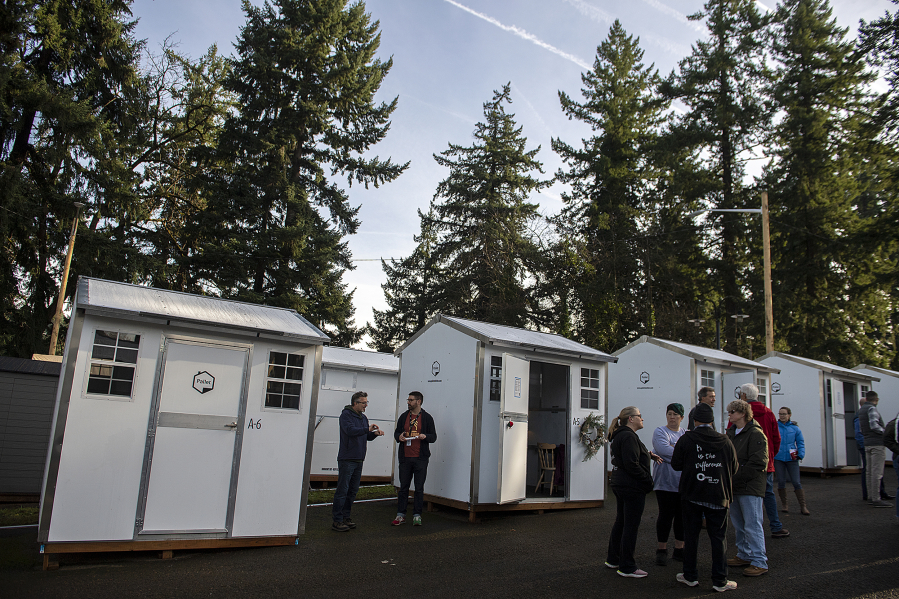This was a big year for local efforts to address housing affordability and homelessness.
To kick off the year, Vancouver voters renewed the levy for the Affordable Housing Fund, a tax of 30 cents per $1,000 in assessed property value. It’s projected to raise $100 million over 10 years.
Lawmakers and advocates declared the Washington Legislature’s 2023 session “the year of housing.”
Housing advocates attempted to pass several bills that aimed to provide more renter protections and affordable housing options statewide. Legislators passed a law to provide more middle housing options (duplexes, cottage clusters and townhomes) statewide, as well as one that lets municipalities zone and build more accessory dwelling units.
Bills that would have provided more protections against rent hikes died, despite many Clark County renters testifying before the Legislature about the benefits.
Several developers have submitted applications to build middle housing since then. Clark County received $250,000 from Washington’s Department of Commerce in November to build more middle housing options.
The Columbian wrote about how difficult it can be to access medical care while experiencing homelessness.
Vulnerable groups continued to experience homelessness at higher rates. The Columbian reported on more seniors becoming homeless in Clark County, as older adults living on fixed incomes continue to be priced out of their units and spend their retirement years on the streets.
Through the story of a former foster youth living on the streets of Vancouver, The Columbian reported on the foster care-to-homelessness pipeline. Seventeen percent of Washington youth aging out of the foster care system were homeless within a year.
Several people whom The Columbian spoke with while they were homeless now have roofs over their heads.
We met J.P. Walmer on his first day of homelessness during a heat spell in July. Walmer appeared in several articles throughout the year. He recently moved into 415 West, Vancouver’s third Safe Stay pallet shelter community.
Katie Vongthonthip and Chance Newbill, who appeared in several articles, moved into their first apartment together in September after more than five years of homelessness.
Sabrina and James Thayer moved from a Safe Stay shelter to a tiny home, where they have lived for more than a year.
Economic trends
Following an all-time peak in average rental prices for apartments in Clark County, rents decreased for the first time in at least five years, according to the Washington Center for Real Estate Research’s apartment market reports.
Even though rents have stabilized, they remain out of reach for many. The Columbian wrote about many people struggling to afford their rent and fearing homelessness.
The funding for pandemic-era programs ended suddenly. Increased Supplemental Nutrition Assistance Program, or SNAP, benefits, also known as food stamps, supported people through a time of high unemployment and school closures during the pandemic.
When benefits decreased to usual levels in March, the average person received about $90 less a month, according to the Center on Budget and Policy Priorities. Food pantries saw lines lengthen.
Eviction filings doubled this summer in Clark County following the end of funding for mediation programs between tenants and landlords.
Substance use and mental health
Providers and people working in homeless outreach continued to fight the rise of fentanyl, which helped drive up overdoses 500 percent in Clark County between 2018 and 2022.
More overdoses are fatal with the introduction of the potent drug into the drug supply. It’s also highly addictive, keeping people hooked; it’s a cheap remedy for intense withdrawal symptoms. Support workers describe the drug as a game-changer.
The continued rise of fentanyl use contributed to the city of Vancouver’s decision to declare a civil emergency.
A small amount of another deadly drug, xylazine (commonly referred to as “Tranq”) was found in Clark County’s drug supply, which officials say they’re monitoring closely.
However, Columbia River Mental Health Services opened a facility called NorthStar, an expansion of its addiction treatment services. The clinic officially opened its doors to clients in November after an appeal by Sonesta International Hotels Corp. delayed it.
The organization also rolled out a mobile team in October that assists people in a mental health crisis along Fourth Plain Boulevard in Vancouver, a similar concept to Eugene, Ore.’s nationally acclaimed CAHOOTS program.
Solutions
The Columbian explored many solutions this year that are working in other communities.
Redmond has used inclusionary zoning for decades to increase its affordable housing stock. The policy, one Vancouver has never explored, requires a certain number of affordable units be included in new apartments.
Just across the Columbia River in Portland, a nonprofit has created a 90-bed recuperative care program to help people experiencing homelessness recover after a hospital stay. The primary care clinic treats patients while staff help them find housing and eliminate barriers to getting help. In Clark County, shelter workers are becoming caregivers, as the county only has five respite beds.
In Seattle, the King County Regional Homelessness Authority created an ombuds program for unhoused residents. The ombuds team investigates complaints and helps people navigate the system.
The Columbian also explored local solutions. About a dozen housing agencies and outreach teams are using data to better understand and assist unhoused residents. The data tracker, known as the by-name list, is a real-time, person-specific list of all people who are homeless here.
“We’re really starting to see tangible results in a very real way now. We got to this place where the numbers are decreasing, and we’re getting results,” said Cody Shaw, coordinated outreach manager for Council for the Homeless.
Coming up next
By the end of 2024, the city of Vancouver expects to open its bridge shelter, a 150-bed congregate shelter that would offer hygiene facilities and connections to community service providers.
The city council will likely discuss plans for the city’s fifth Safe Stay shelter and a second Safe Park, where people can live in their vehicles.
The state Legislature will also consider several bills to combat the state’s housing crisis, including a rent relief program and a bill establishing accountability requirements for homeless housing grant programs.





